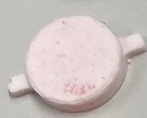13. Molding and casting¶
Adam Durrett: Casting Materials and Documenting Results Zack Budzichowski: Documentation and Analysis Dan Stone: Casting and overview documentation
Review the safety data sheets for each of your molding and casting materials:
Then make and compare test casts with each of them
Material Comparison¶
We compared a number of different casting materials including:
OOMOO 30 Silicone Mold Making Rubber
Smooth-Cast 300 Liquid Plastic
We had reviewed all the data sheet and then made test casts of each as you can see (same order as the list above)
| Material | Picture | Description | Safety Notes |
|---|---|---|---|
| OOMOO 30 | OOMOO 30 creates a very sturdy, but flexible silicone rubber with a high friction coefficient. It is ideal for making molds or giving a material cushioning. Compared to the Mold Star 16, this seems to be a tougher and longer-lasting rubber. | “Room size” ventilation, Wear safety glasses, long sleeves and rubber/vinyl gloves to minimize contamination risk. Latex gloves will inhibit cure of rubber. Store at room temperature(73F/23C) | |
| Smooth-Cast 300 |  |
Smooth-Cast 300 creates a very clean and crisp casting, with a very rigid structure. This material is inflexible, but can capture all of the tiny details in a mold. | Well ventilated area. Wear safety glasses, long sleeves and rubber/vinyl gloves to minimize contamination risk. Store at room temperature(73F/23C) |
| Smooth-Cast 65D |  |
This semi-rigid resin creates a very “smooth” cast (hence the name) with some bendability. We found that if the part is ~cm thick it is very rigid, but thin parts (a few mm) were flexible and bendable. It would return back to its original molded shape as well. | Well ventilated area. Wear safety glasses, long sleeves and rubber/vinyl gloves to minimize contamination risk. Store at room temperature(73F/23C) |
| Mold Star 16 | This silicone creates a very sturdy but flexible non-stick material, ideal for making molds. It could potentially be used for parts that need cushioning or impact resistance, but its flexible nature helps it hold shape when creating casts, and allows for easy removal of cured parts. | “Room size” ventilation, Wear safety glasses, long sleeves and rubber/vinyl gloves to minimize contamination risk. Latex gloves will inhibit cure of rubber. Store at room temperature(73F/23C) | |
| Task-8 Resin |  |
Task-8 creates a hard, and very rigid plastic part, with a fairly smooth cast to boot. It seems like bubbles are easier to form while curing compared to the 65D, but has the advantage of sturdiness and inflexibility. | “Room size” ventilation, Wear safety glasses, long sleeves and rubber/vinyl gloves to minimize contamination risk. Latex gloves will inhibit cure of rubber. Store at room temperature(73F/23C) |
| UV Resin |  |
This UV resin probably creates the worst results of the group, but its convenient and easy. The material has some slight flex to it, and isn’t nearly as smooth as the other casting materials used above. I think this material would be good for quick prototyping, small stress-free components, and anything where a quick see-through cast is needed. This one also took the color pigment the best, where as the others seemed to mute the intensity of the added pigments. | Well ventilated area. Wear safety glasses, long sleeves and rubber/vinyl gloves to minimize contamination risk. Store at room temperature(73F/23C) |
Last update:
April 26, 2023